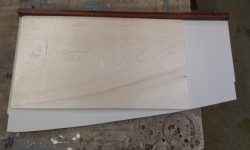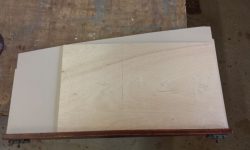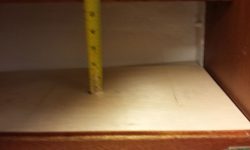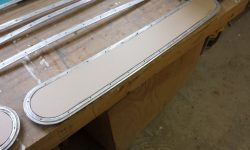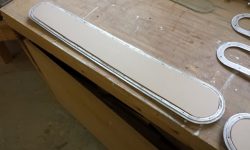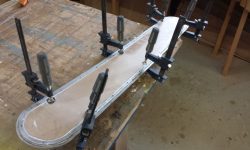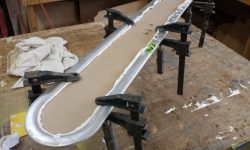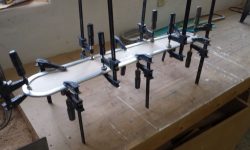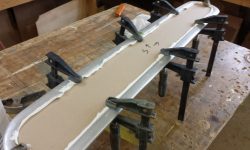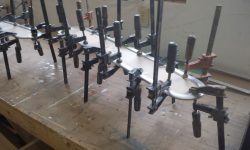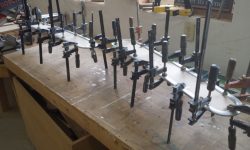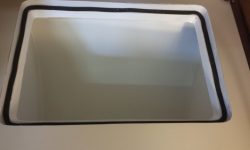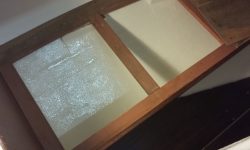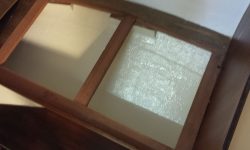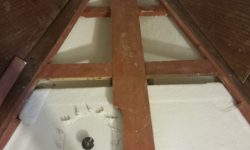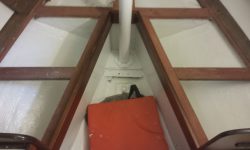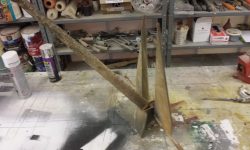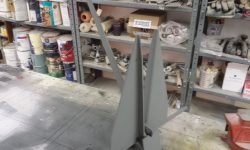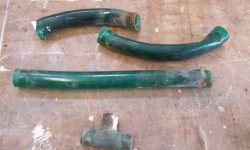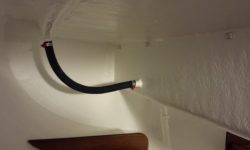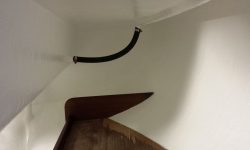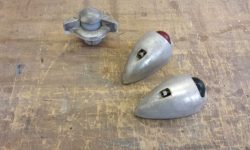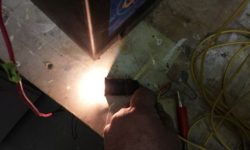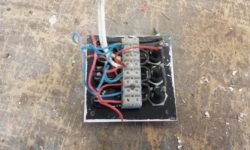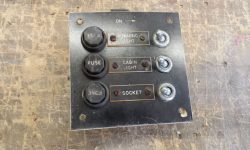March 10, 2017
Halcyon 51
Friday
The owners asked about a small stovetop to fit the little sliding shelf above the head, and to test one of the options, a two-burner alcohol stove, I made up a template to the maximum dimensions of the base, as it appeared the fit might be tight. And it was tight, but it did look like this stove would fit on the shelf without hitting the hull, and there was enough vertical clearance beneath the fixed shelf above too. Sorry for the blur in the last photo, but the stove required 5-3/8″ headroom, and the space had about 5-3/4″.
From a sheet of new clear 3/16″ acrylic, I cut two new lenses for the deadlights, using the old ones as patterns and fine-tuning as necessary. With the lens held in place in the outer frame, I used a knife to trim the protective paper coating at the edges of the frame, to expose the plastic in the bonding area for the next step.
To prepare for final installation on the boat, for which I’d need an additional pair of hands that I’d arrange soon, I decided to pre-install the lenses in the outer frames, using the light adhesive polyurethane sealant that I use for all general purpose bedding. For each frame, I applied a good bead of sealant to the shallow, narrow rabbet on the inside of the frame, then pressed in the lens, clamping it securely. I cleaned up the bulk of the squeeze out now, concentrating mainly on the frames, since I could trim excess on the paper later, once the sealant cured. With both lenses clamped in place, I set them aside for a good long cure. This also held the built-in curvature in the aluminum frames, which corresponded to the shape of the cabin trunk. I used lots of clamps to ensure a consistent and secure bond and seal.
After final preparations, I painted all the locker areas beneath the berths, as well as the inside of the icebox. I’d previously sanded and prepared these areas during the interior phase of the project.
From my little supply of random anchors, I found a suitable replacement anchor for the badly rusted/seized original that I’d removed from the boat. The anchor was in good condition, but didn’t look terrific as is, so I cleaned it up and applied a spray coat of cold-galvanized primer. Later, I planned to overcoat this with a topcoat, but I didn’t have the paint on hand so I’d complete that once I received the new paint.
I was ready to install new scupper hoses, both for the seat drains located at the aft end of the cockpit, as well as the main scuppers at the forward end. I had all the hose on hand that I needed, but I found I didn’t have the proper hose clamps for the larger main scupper hoses, so for now I left those incomplete while awaiting the order. However, I installed new hoses and clamps for the aft seat drains.
Along with some good replacement cleats and the aft chocks, one of the semi-precious finds in my lot of hardware was original running light housings, which matched the ones I’d removed from this boat but were in much better condition; the originals had half-disintegrated when I removed them. The housings, lenses, and castings for the replacements were sound, and from the four lights I found two socket assemblies that were good to go and tested operational.
The stern light housing didn’t have a socket within at all, so I ordered some new sockets to arrive soon so I could rebuild that fixture as well. Meanwhile, I’d clean up and rewire the two sidelight housings to prepare them for installation.
I had originally planned and hoped to reuse the small electrical panel that I’d removed, but as I removed old wires and prepared to reinvigorate the old panel, I found that the little terminal block was in poor condition, and that this, along with some other shortfalls of the panel such as rusted fuse holders and a faded and somewhat cracked faceplate with rusted fasteners, meant that it didn’t make any sense to continue and waste more time on a lost cause. Instead, I found a simple new 3-position fuse panel that I’d use instead, and ordered it. I’d probably have to modify the little support box in the cabin to accommodate the new panel, but I’d determine that once the panel was on hand.
Total time billed on this job today: 5.75 hours
0600 Weather Observation:
20°, mostly cloudy. Forecast for the day: mostly cloudy, possible snow showers, 28°



